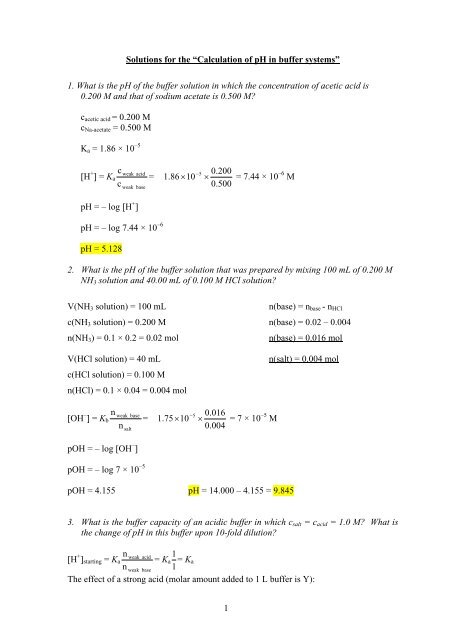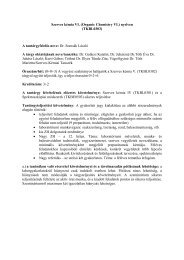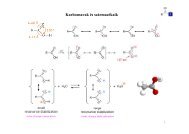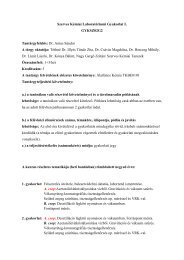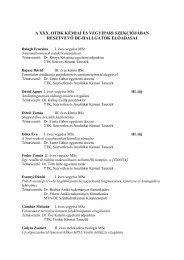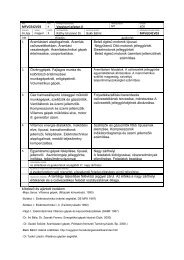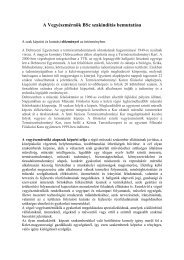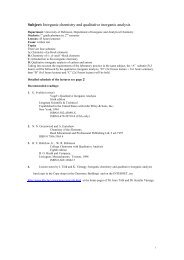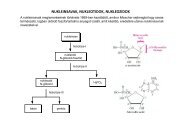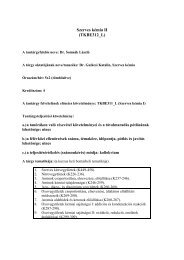Solutions for the “Calculation of pH in buffer systems”
Solutions for the “Calculation of pH in buffer systems”
Solutions for the “Calculation of pH in buffer systems”
Create successful ePaper yourself
Turn your PDF publications into a flip-book with our unique Google optimized e-Paper software.
<strong>Solutions</strong> <strong>for</strong> <strong>the</strong> <strong>“Calculation</strong> <strong>of</strong> <strong>pH</strong> <strong>in</strong> <strong>buffer</strong> <strong>systems”</strong>1. What is <strong>the</strong> <strong>pH</strong> <strong>of</strong> <strong>the</strong> <strong>buffer</strong> solution <strong>in</strong> which <strong>the</strong> concentration <strong>of</strong> acetic acid is0.200 M and that <strong>of</strong> sodium acetate is 0.500 M?c acetic acid = 0.200 Mc Na-acetate = 0.500 MK a = 1.86 × 10 –5[H + cweak acid] = K acweak base<strong>pH</strong> = – log [H + ]=1.86 × 10− 5 ×0.2000.500= 7.44 × 10 –6 M<strong>pH</strong> = – log 7.44 × 10 –6<strong>pH</strong> = 5.1282. What is <strong>the</strong> <strong>pH</strong> <strong>of</strong> <strong>the</strong> <strong>buffer</strong> solution that was prepared by mix<strong>in</strong>g 100 mL <strong>of</strong> 0.200 MNH 3 solution and 40.00 mL <strong>of</strong> 0.100 M HCl solution?V(NH 3 solution) = 100 mLn(base) = n base - n HClc(NH 3 solution) = 0.200 M n(base) = 0.02 – 0.004n(NH 3 ) = 0.1 × 0.2 = 0.02 moln(base) = 0.016 molV(HCl solution) = 40 mLc(HCl solution) = 0.100 Mn(HCl) = 0.1 × 0.04 = 0.004 moln(salt) = 0.004 mol[OH – n] = K bnweak basesalt=1.75×10− 5 ×0.0160.004= 7 × 10 –5 MpOH = – log [OH – ]pOH = – log 7 × 10 –5pOH = 4.155 <strong>pH</strong> = 14.000 – 4.155 = 9.8453. What is <strong>the</strong> <strong>buffer</strong> capacity <strong>of</strong> an acidic <strong>buffer</strong> <strong>in</strong> which c salt = c acid = 1.0 M? What is<strong>the</strong> change <strong>of</strong> <strong>pH</strong> <strong>in</strong> this <strong>buffer</strong> upon 10-fold dilution?[H + nweak acid1] start<strong>in</strong>g = K a = K a = Kanweak base 1The effect <strong>of</strong> a strong acid (molar amount added to 1 L <strong>buffer</strong> is Y):1
[H + ] = 10×[H + 1+ Y] start<strong>in</strong>g = 10 × K a = K a ×1- Y1+ Y10 =1- Y10 – 10Y = 1 + YY = 0.81818 MThe effect <strong>of</strong> a strong base (molar amount added to 1 L <strong>buffer</strong> is Z):[H + ] = 0.1×[H + 1 − Z] start<strong>in</strong>g = 0.1 × K a = K a ×1 + Z1 − Z0.1 =1 + Z0.1 + 0.1Z = 1 – ZZ = 0.81818 MDilution does not change <strong>the</strong> <strong>pH</strong> <strong>of</strong> this <strong>buffer</strong>, because [H + n] = K annweak acidratio does not cange with dilution.nweak baseweak acidweak baseand <strong>the</strong>4. What is <strong>the</strong> <strong>buffer</strong> capacity <strong>of</strong> a 1.0 M HCl solution? What is <strong>the</strong> change <strong>of</strong> <strong>pH</strong> <strong>in</strong> this<strong>buffer</strong> upon 10-fold dilution?[H + ] start<strong>in</strong>g = 1 M, so <strong>pH</strong> start<strong>in</strong>g = 0.00The effect <strong>of</strong> a strong acid:[H + ] = 10 MThe added amount <strong>of</strong> strong acid is 10M – 1M = 9 MThe effect <strong>of</strong> a strong base:[H + ] = 0.10 MThe added amount <strong>of</strong> strong base is 1M – 0.1M = 0.9 MAfter a 10-fold dilution, [H + ] = 0.10 M, <strong>pH</strong> = 1.005. What volume <strong>of</strong> 0.1 M NaOH or 0.1 M HCl causes 1 unit change <strong>in</strong> <strong>the</strong> <strong>pH</strong> <strong>of</strong> 1 dm 3 <strong>of</strong>acetate <strong>buffer</strong>, which has a <strong>pH</strong> <strong>of</strong> 5.000 and <strong>the</strong> sum <strong>of</strong> <strong>the</strong> acetate and <strong>the</strong> acetic acidconcentrations is exactly 1.00 M?<strong>pH</strong> = 5.00, so [H + ] = 10 -5 M[H + nweak acid] = K anweak base10 -5 = 1.86×10 -5 nweak×nacidweak base (orsalt)= 1.86×10 -5 n×1- nweak acidweak acidBy solv<strong>in</strong>g this equation, n weak acid = 0.34965 M and n weak base = 0.65035 MThe effect <strong>of</strong> a strong acid (molar amount: X):<strong>pH</strong> = 5.00 – 1 = 4.00, so [H + ] = 10 -4 M10 -4 = 1.86×10 -5 0.34965 + X×0.65035 - XX = 0.49352 mol strong acid can be added to decrease <strong>the</strong> <strong>pH</strong> by 1 unit.We know <strong>the</strong> concentration (0.1 M), so <strong>the</strong> volume can be calculated:2
n 0.49352 molV = == 4.9352 Lc 0.1 mol/LThe effect <strong>of</strong> a strong base (molar amount: Y):<strong>pH</strong> = 5.00 + 1 = 6.00, so [H + ] = 10 -6 M10 -6 = 1.86×10 -5 0.34965 − Y×0.65035 + YY = 0.2986 mol strong base can be added to <strong>in</strong>crease <strong>the</strong> <strong>pH</strong> by 1 unit.We know <strong>the</strong> concentration (0.1 M), so <strong>the</strong> volume can be calculated:n 0.2986 molV = == 2.986 Lc 0.1 mol/L6. A <strong>buffer</strong> with <strong>pH</strong> = 9.25 is needed from 100 cm 3 <strong>of</strong> 2.00 M ammonia solution and anunlimited amount <strong>of</strong> solid NH 4 Cl. What is <strong>the</strong> mass <strong>of</strong> ammonium chloride needed?What is <strong>the</strong> f<strong>in</strong>al <strong>pH</strong> <strong>of</strong> this <strong>buffer</strong> solution after <strong>the</strong> addition <strong>of</strong> 50 or 500 cm 3 <strong>of</strong> 1.00M HCl?<strong>pH</strong> = 9.25pOH = 14 – <strong>pH</strong> = 4.75[OH - ] = 10 -pOH = 1.778×10 -5 M[OH - cweak base] = K b ⋅csalt1.778 × 10 -5 = 1.75 × 10 -5 2 M⋅csaltFrom this, c salt = 1.9682 M. We know <strong>the</strong> volume (100 mL), so <strong>the</strong> molar amount <strong>of</strong> <strong>the</strong>salt can be calculated: n = c × V = 1.9682 M × 0.1 L = 0.19682 mol.We also know <strong>the</strong> M.W. <strong>for</strong> NH 4 Cl (53.5 g/mol), so m = n × M.W. = 10.53 g NH 4 ClAfter <strong>the</strong> addition <strong>of</strong> 50 mL 1 M HCl:n HCl = 0.050 mL × 1 M = 0.050 mol[OH - nweak base] = K b ⋅ = 1.75 × 10 -5 0.2 - 0.050⋅=1.06352 × 10 -5 Mnsalt0.19682 + 0.050pOH = -log(1.06352 × 10 -5 ) = 4.973, <strong>pH</strong> = 14.00 – pOH = 9.027After <strong>the</strong> addition <strong>of</strong> 500 mL 1 M HCl:n HCl = 0.50 mL × 1 M = 0.50 molThe total volume <strong>of</strong> <strong>the</strong> result<strong>in</strong>g solution is 600 mL (500 mL + 100 mL)In this solution, we have 0.39682 mol NH 4 Cl (0.2 + 0.19682) and 0.3 mol HCl (0.5 – 0.2).So, take only <strong>the</strong> strong acid <strong>in</strong>to consideration.0.3 molc HCl = = 0.5 M = [H + ], and <strong>pH</strong> = -log(0.5) = 0.3010.6 L3


